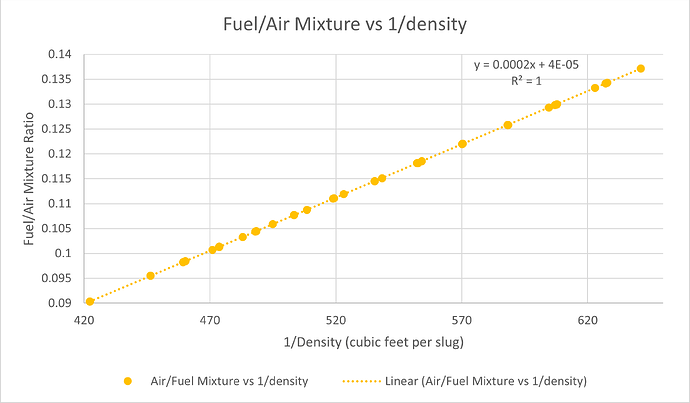The engines.cfg file contains options to define a turbocharged piston engine
as follows: engine_type = 0 ; 0 = piston turbocharged = 1 ; Is it
turbocharged? 1 = TRUE When creating an aircraft with these options, the fuel
mixture behavior incorrectly varies with altitude. A turbocharged engine is
capable of maintaining full power manifold pressure up to the turbocharger’s
critical altitude. Because of this, the fuel/air ratio will remain relatively
constant with altitude (below the critical altitude) as long as the mixture
lever is not adjusted. Currently in MSFS, with engine_type = 0 and
turbocharged = 1, the fuel/air ratio increases with altitude regardless of
whether the airplane is above or below critical altitude. This results in loss
of power and eventual inability to climb without leaning the mixture. I
collected test data from the sim using the stock G36 Bonanza with turbocharged
= 1 and critical_altitude = 18000. The data shows that fuel/air ratio varies
with ambient air density:
behavior is correct for a naturally-aspirated engine, but a turbocharger
increases the manifold pressure (and therefore density) above the ambient
value. To make matters more unrealistic, fuel flow gradually decreases at
higher altitudes when mixture is full rich. Here are some test data I
collected by modifying the stock G36 Bonanza with turbocharged=1: Fuel Flow
(gph) and Altitude (Full Rich Mixture) 2,000 ft: 23.5 gph 3,000 ft: 23.6 gph
4,000 ft: 23.7 gph 5,000 ft: 23.8 gph 6,000 ft: 23.7 gph 7,000 ft: 23.1 gph
8,000 ft: 21.3 gph 9,000 ft: 19.4 gph 10,000 ft: 14.8 gph 11,000 ft: 7.7 gph
12,000 ft: 0.5 gph I performed another test flight and manually leaned the
mixture at 1,000 ft intervals until I found the maximum fuel flow. Here are
the results: Altitude: Max Fuel Flow: 2,000 ft: 23.6 gph at 94% mixture 3,000
ft: 23.7 gph at 91% mixture 4,000 ft: 23.9 gph at 64% mixture 5,000 ft: 24.0
gph at 66% mixture 6,000 ft: 24.1 gph at 54% mixture 7,000 ft: 24.2 gph at 52%
mixture 8,000 ft: 24.3 gph at 50% mixture 9,000 ft: 24.4 gph at 48% mixture
10,000 ft: 24.5 gph at 44% mixture 11,000 ft: 24.6 gph at 42% mixture 12,000
ft: 24.6 gph at 40% mixture To summarize: when turbocharged = 1 and mixture is
full-rich, fuel/air mixing ratio increases with altitude and fuel flow
decreases with altitude in MSFS. In reality, fuel/air mixing ratio and fuel
flow should be relatively constant below the critical altitude. The maximum
fuel flow numbers reported above demonstrate that the MSFS turbocharged engine
model is capable of producing full-power fuel flows at high altitude, but
mixture must be leaned to realize that performance – an unrealistic result.
As a simplistic approximation, it would be better to assume a constant
relationship between mixture lever percentage and fuel/air ratio when
turbocharged = 1 (in other words, fuel/air ratio would be independent of
altitude). For more advanced development, it would be useful to include
options for behavior above critical altitude (Option 1: constant fuel/air
ratio with altitude. Option 2: increasing fuel/air ratio with altitude above
critical altitude). Fuel/air ratio will also depend on the density of air
delivered to the cylinders. In a turbocharged engine, this is affected by
compression heating and intercooler effectiveness.
